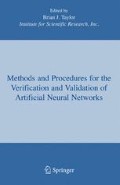3. Summary
A novel approach for validation of soft computing systems (neural network) embedded in safety-critical online self-adaptive systems is presented in the form of run-time risk assessment methodology. The approach is based on run-time operational monitoring of the neural network and data fusion techniques for combining outputs from various monitors. The run-time monitoring is based on the stability analysis of dynamic systems similar, in principle, to the Lyapunov analysis. The outputs from various monitors are fused together to form a single measure of confidence from the data fusion techniques of Dempster-Shafer (Murphy’s rule of combination) and Fuzzy Inference System.
The developed concept of run-time monitoring and data fusion can serve as a powerful tool for assessing risk in real-time and a complementary means of validating on-line self-adaptive systems in cases where traditional validation techniques fail or cannot be applied. Using the data collected from an F-15 flight simulator, heuristic evidence is provided that supports the prospects of using run-time monitoring and data fusion techniques to form a run-time risk assessment methodology. This work can be viewed as a step towards a solution to the V&V of online self-adaptive systems. This is a complex yet very important problem facing the dependability research community. It is believed that the application boundaries for adaptive and intelligent systems will widen as the underlying software/system verification and validation theory becomes better understood and derived techniques achieve a higher level of maturity. Current work on this approach consists of fine-tuning the fuzzy inference system (modifying rules, membership functions) and providing a signaling system, similar to traffic control system that can warn the pilot/aircraft validation engineers of an imminent threat due to neural network misbehavior.
Access this chapter
Tax calculation will be finalised at checkout
Purchases are for personal use only
Preview
Unable to display preview. Download preview PDF.
References
Bruske, Jorg and Gerald Sommer. 1994. Dynamic Cell Structures. In Proceedings of Neural Information Processing Systems (NIPS), 497–504.
Jorgensen, Charles C. 1997. Direct Adaptive Aircraft Control Using Dynamic Cell Structure Neural Networks. NASA Technical Memorandum 112198, NASA Ames Research Center.
Kohonen, T. 1988. Self-Organization and Associative Memory, Second Edition, Springer-Verlag, New York.
Mamdani, E.H. and S. Assilian. 1975. An Experiment in Linguistic Synthesis with a Fuzzy Logic Controller. InternationalJournal of Man-Machine Studies. Vol. 7, No. 1, pp. 1–13.
Murphy, Robin R. 1998. Dempster-Shafer Theory for Sensor Fusion in Autonomous Mobile Robots. IEEE Trans. Robotics and Automation. vol. 14, no. 2, pp. 97206.
Murphy, Robin R. 1996. Adaptive Rule of Combination for Observations Over Time. Multisensor Fusion and Integration for Intelligent Systems (MFI96), Dec. 8–11, 1996, pp.125–131.
Smets, Phillipe. 1990. The Combination of Evidence in the Transferable Belief Model. IEEE Transactions on Pattern Analysis and Machine Intelligence. Vol. 12, No. 5, May 1990.
Yerramalla, Sampath; Yan Liu; Edgar Fuller; Bojan Cukic; and Srikanth Gururajan. 2004. An Approach to V&V of Embedded Adaptive Systems. III NASA-Goddard /IEEE Workshop on Formal Approaches to Agent Based Systems.
Yerramalla, Sampath; Edgar Fuller; and Bojan Cukic. 2004. A Validation Approach for Neural Network Based Online Self-adaptive Systems. Submitted for publication at the Special Issue of Software, Practice and Experience Journal on Experiences with Auto-Adaptive and Reconfigurable Systems.
Yerramalla, Sampath; Yan Liu; Edgar Fuller; Bojan Cukic; and Srikanth Gururajan. 2004. Adaptive Control Software: Can We Guarantee Safety? Submitted for publication at the First International Workshop on Software Cybernetics.
Author information
Authors and Affiliations
Rights and permissions
Copyright information
© 2006 Springer Science+Business Media, Inc.
About this chapter
Cite this chapter
Cukic, B., Fuller, E., Mladenovski, M., Yerramalla, S. (2006). Run-Time Assessment of Neural Network Control Systems. In: Methods and Procedures for the Verification and Validation of Artificial Neural Networks. Springer, Boston, MA. https://doi.org/10.1007/0-387-29485-6_10
Download citation
DOI: https://doi.org/10.1007/0-387-29485-6_10
Publisher Name: Springer, Boston, MA
Print ISBN: 978-0-387-28288-6
Online ISBN: 978-0-387-29485-8
eBook Packages: Computer ScienceComputer Science (R0)

